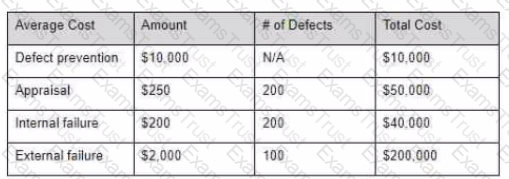Your defect opened trend is converging to the closed trend but there is still a gap. What does that gap represent?
Your team has decided that they will build their own test management tool This will allow them to link the requirements and testcases together providing full traceability It will also allow them to create fully customized reporting and color-coded dashboards They have estimated the time required to create the new tool and the cost These fit within the project schedule and budget
What other consideration should be taken before this decision is made?
You have assembled the following cost of quality numbers 200 defects were found prior to release and 100 were found after.
Given this information what is the total cost of quality for this project?

Which of the following is required to apply an experience-based testing approach''
What is the purpose of lest control?
You have been looking at the actual vs expected defects in one high risk area of the software The actual is much higher than the expected value What should you do?
Your team has been assigned to test a loyalty card programfor a supermarket chain.Because this is a highly competitive market significant investment has been made to determine the shortcomings of the products offered by competitors While the feature sets are mostly the same, there is a wide variance In usability and performance and the users perceptions of these quality characteristics
Given only this information what test approach would be most appropriate?
You are working for an outsource testing company You have a client that will only consider candidates that are highly skilled with Salesforce. regardless of the number of years they have spent testing similar products You have looked through your skills matrix and you have no one with the right type of experience for this project.
What competence area is your team lacking?
Which of the Mowing should be used to understand the context of testing within an organization?
You tend to be conservative in your project estimations because you know how many things can go wrong and extend the schedule. You manager is not happy with your estimates and thinks you are being too negative with your numbers and not trying hard enough Which estimation method should you use to provide your manager with a positive' number while still also providing the number you think is more realistic?
Your organization has decided to augment your testing team with an offshore team. The offshore team members are experienced testers who are experts in the domain of the system under test Your team isworried about the offshore team taking their jobs and they are resistant to the change You need to pick three of your team members to be the ambassadors for the new team
Which competences will be most important for your ambassadors to possess?
In whatway is the operations team usually Involved In testing7
You have assembled the following cost of quality numbers 1 000 defects were found prior to release and 100 were found after.

Given this information what should you conclude?
You have been asked to estimate the testing effort for an upgrade to a legacy product Your team did the testing on the last upgrade, and you have ascertained that this upgrade is about 10% bigger than the last one Given this information which estimation technique should you use to come up with the test effort number?
Your manager has decided thatyour team of manual testers should all become test automation engineers Your team is much stronger in analysis than In technical testing so youare concerned about their abilityto adapt.What tool capabilities could help with this transition?